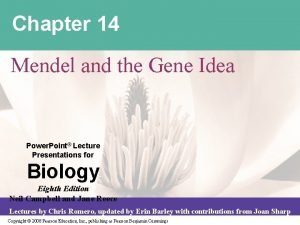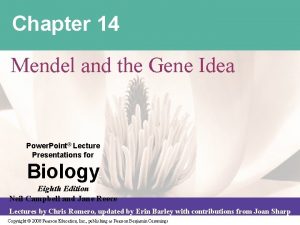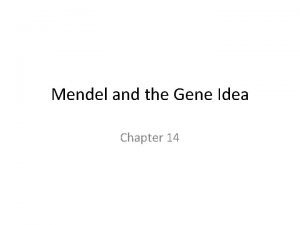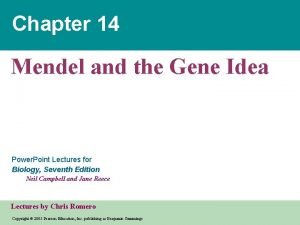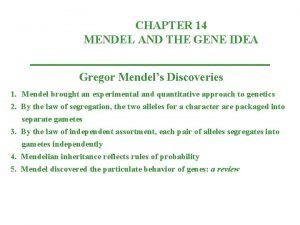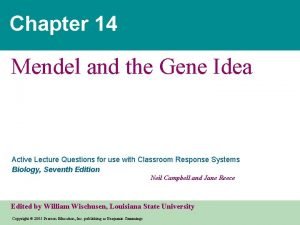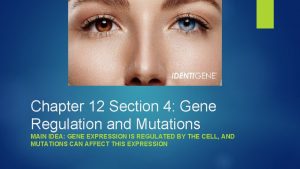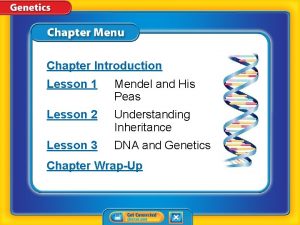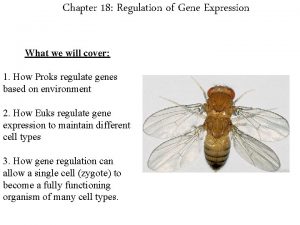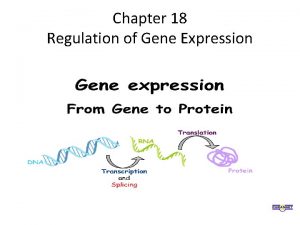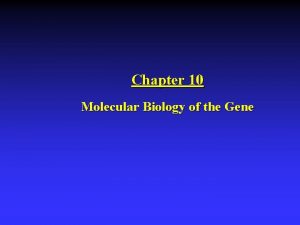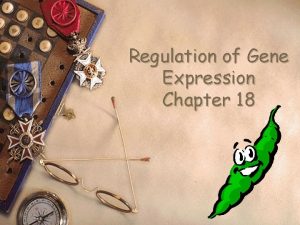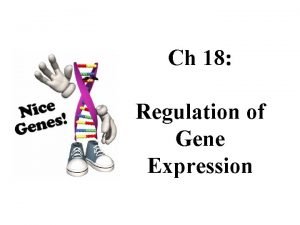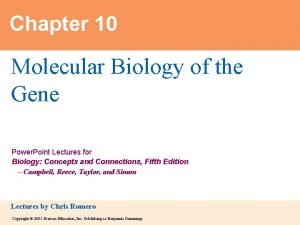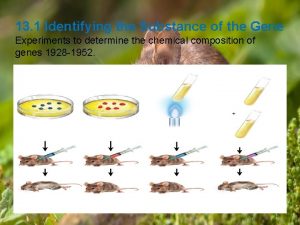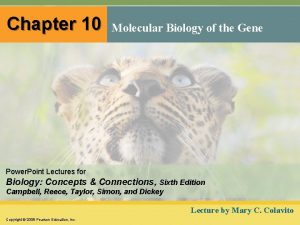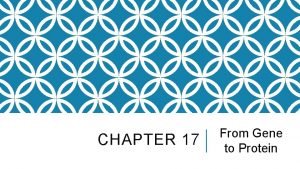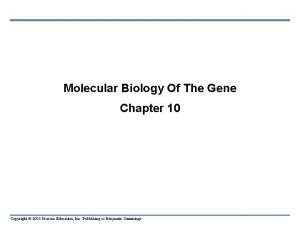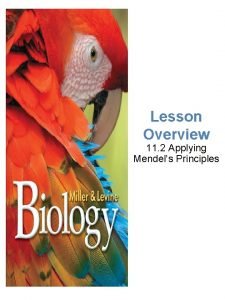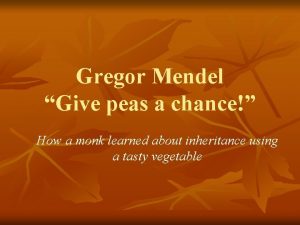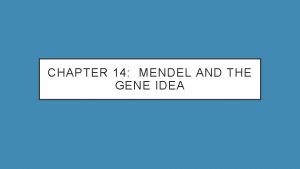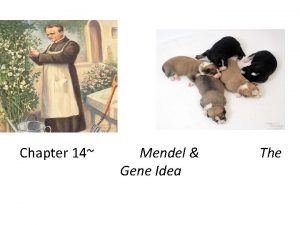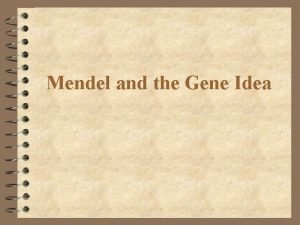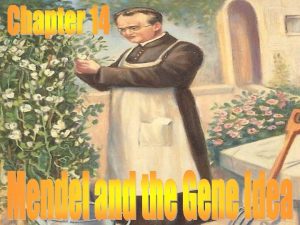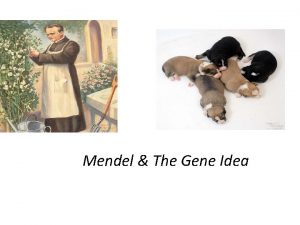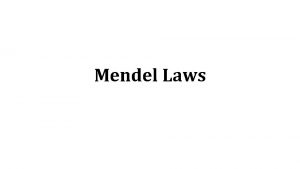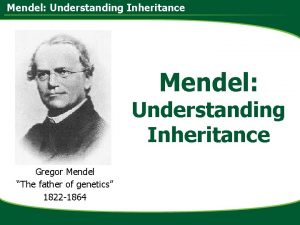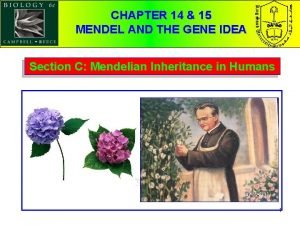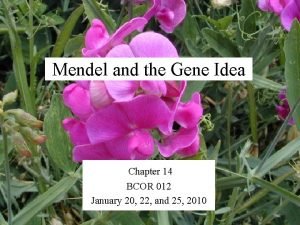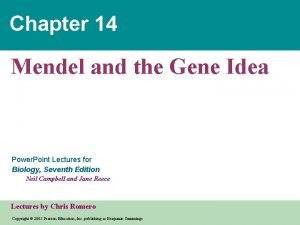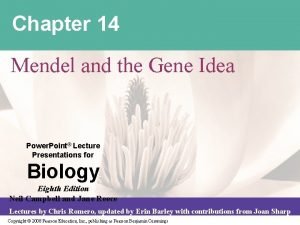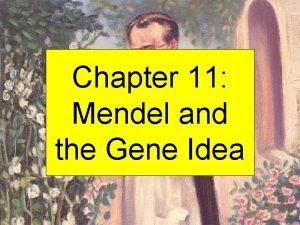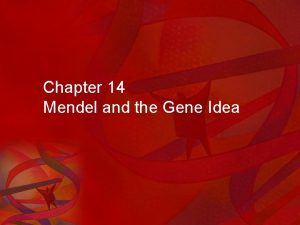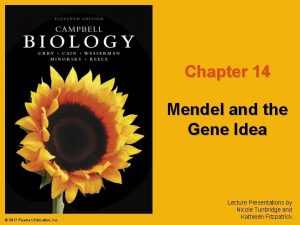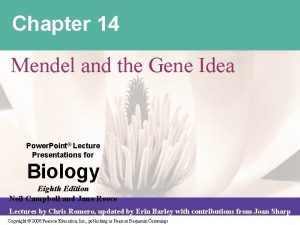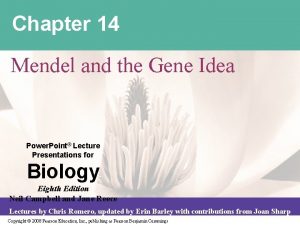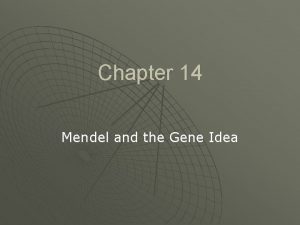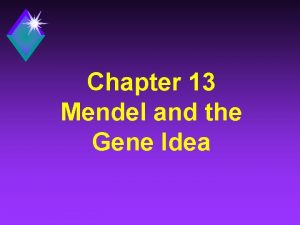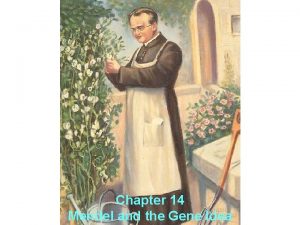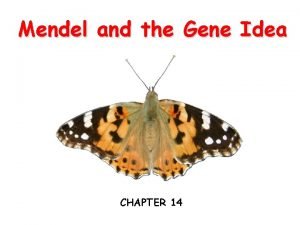CHAPTER 14 MENDEL AND THE GENE IDEA Mendel








































































- Slides: 72

CHAPTER 14 MENDEL AND THE GENE IDEA

Mendel brought an experimental and quantitative approach to genetics • Gregor Mendel grew up on a small farm in what is today the Czech Republic. • 1843 - entered an Augustinian monastery. • 1851 to 1853 - studied at the University of Vienna. • Taught at the Brunn Modern School and lived in the local monastery. • 1856 - 1863 Mendel breed garden peas to study inheritance, cultivating and testing 29, 000 pea plants.

Pea plants have several advantages for genetics. • Many varieties with distinct heritable features (characters) with different variants (traits). • Had control over which plants mated with which. • Pea plants typically self-fertilize, fertilizing ova with their own sperm. • However, Mendel could also move pollen from one plant to another to cross-pollinate plants.

Mendel would cross-pollinate (hybridize) two contrasting, true-breeding pea varieties. • The true-breeding parents are the P generation and their hybrid offspring are the F 1 generation (first filial generation). Mendel would then allow the F 1 hybrids to selfpollinate to produce an F 2 generation. Mendel’s quantitative analysis of F 2 plants revealed the two fundamental principles of heredity: the law of segregation and the law of independent assortment.

Law of segregation- the two alleles for a character are packaged into separate gametes • When Mendel allowed the F 1 plants to self-fertilize, the F 2 generation included both purple-flowered and white-flowered plants. • The white trait, absent in the F 1, reappeared in the F 2. This cross produced a three purple to one white ratio of traits in the F 2 offspring,

• Mendel reasoned that the heritable factor for white flowers was present in the F 1 plants, but it did not affect flower color. • Purple flower is a dominant trait and white flower is a recessive trait. • Mendel found similar 3 to 1 ratios of two traits among F 2 offspring when he conducted crosses for six other characters, each represented by two different varieties.


Law of segregation 1. Different alleles account for variations in inherited characters. • Different alleles vary somewhat in the sequence of nucleotides at the specific locus of a gene. • The purple-flower allele and white-flower allele are two DNA variations at the flower-color locus.

Law of segregation 2. For each character, an organism inherits two alleles, one from each parent. • Alleles may be identical, ex: the true-breeding plants of the P generation. • Alleles may be different, ex: the F 1 plants with a purple-flower allele and a white-flower allele

Law of segregation 3. If two alleles differ, then one, the dominant allele, is fully expressed in the organism’s appearance. • The other, the recessive allele, has no noticeable effect on the organism’s appearance. • Mendel’s F 1 plants had purple flowers because the purple-flower allele is dominant and the white-flower allele is recessive.

Law of segregation 4. The two alleles for each character segregate (separate) during gamete production. • The segregation of alleles corresponds to the distribution of homologous chromosomes to different gametes in meiosis.

• Punnett squarepredicts the results of a genetic cross between individuals of known genotype.

• Homozygous- an organism with two identical alleles for a character • Heterozygous- an organism with two different alleles for a character • Phenotype- description of an organism’s traits • Genotype- description of an organism’s genetic makeup • Two organisms can have the same phenotype but have different genotypes.

• For flower color in peas, both PP and Pp plants have the same phenotype (purple) but different genotypes (homozygous and heterozygous).

• Test cross- breeding a homozygous recessive with dominant phenotype, but unknown geneotype, can determine the identity of the unknown allele.

Law of Independent Assortment- each pair of alleles segregates into gametes independently • Monohybrid cross- experiment following the inheritance of a single character. • Dihybrid cross- experiment following the inheritance of two different characters.

• In one dihybrid cross experiment, Mendel studied the inheritance of seed color and seed shape. • The allele for yellow seeds (Y) is dominant to the allele for green seeds (y). • The allele for round seeds (R) is dominant to the allele for wrinkled seeds (r). • Mendel crossed true-breeding plants that had yellow, round seeds (YYRR) with true-breeding plants that has green, wrinkled seeds (yyrr).

• One possibility is that the two characters are transmitted from parents to offspring as a package. • The Y and R alleles and y and r alleles stay together. • If this were the case, the F 1 offspring would produce yellow, round seeds. • The F 2 offspring would produce two phenotypes in a 3: 1 ratio, just like a monohybrid cross. • This was not consistent with Mendel’s results.

• An alternative hypothesis is that the two pairs of alleles segregate independently of each other. • The presence of one specific allele for one trait has no impact on the presence of a specific allele for the second trait. • In our example, the F 1 offspring would still produce yellow, round seeds. • However, when the F 1’s produced gametes, genes would be packaged into gametes with all possible allelic combinations. • Four classes of gametes (YR, Yr, y. R, and yr) would be produced in equal amounts.

• When sperm with four classes of alleles and ova with four classes of alleles combined, there would be 16 equally probable ways in which the alleles can combine in the F 2 generation. • These combinations produce four distinct phenotypes in a 9: 3: 3: 1 ratio. • This was consistent with Mendel’s results.

• Mendel repeated the dihybrid cross experiment for other pairs of characters and always observed a 9: 3: 3: 1 phenotypic ration in the F 2 generation. • Each character appeared to be inherited independently.

Mendelian inheritance reflects rules of probability The probability of tossing heads with a normal coin is 1/2. Like a coin toss, each gamete from a heterozygous parent has a 1/2 chance of carrying the dominant allele and a 1/2 chance of carrying the recessive allele.

• Rule of multiplication- determines the chance that two or more independent events will occur together in some specific combination. • Compute the probability of each independent event. • Then, multiply the individual probabilities to obtain the overall probability of these events occurring together. • The probability that two coins tossed at the same time will land heads up is 1/2 x 1/2 = 1/4. • The probability that a heterogyzous pea plant (Pp x Pp) will produce a white-flowered offspring (pp) is 1/2 x 1/2 = 1/4.

• Dihybrid crosses: • For a heterozygous parent (Yy. Rr) the probability of producing a YR gamete is 1/2 x 1/2 = 1/4. • The probability that an F 2 plant will have a YYRR genotype from a heterozygous parent is 1/16 (1/4 chance for a YR ovum and 1/4 chance for a YR sperm).

• Rule of addition- the probability of an event that can occur two or more different ways is the sum of the separate probabilities of those ways. There are two ways that F 1 gametes (Pp x Pp) can combine to form a heterozygote. • The dominant allele (P) could come from the sperm and the recessive (p) from the ovum (probability = 1/4). • Or, the dominant allele (P) could come from the ovum and the recessive (p) from the sperm (probability = 1/4). • The probability of a heterozygote (Pp) is 1/4 + 1/4 = 1/2.

Combine the rules of multiplication and addition: • What is the probability of finding two recessive phenotypes for at least two of three traits resulting from a trihybrid cross between pea plants that are Pp. Yy. Rr and Ppyyrr? • There are five possible genotypes that fulfill this condition: ppyy. Rr, pp. Yyrr, Ppyyrr, PPyyrr, and ppyyrr. • Use the rule of multiplication to calculate the probability for each of these genotypes and then use the rule of addition to pool the probabilities for fulfilling the condition of at least two recessive trait.

• Pp. Yy. Rr and Ppyyrr: • The probability of producing a ppyy. Rr offspring: • The probability of producing pp = 1/2 x 1/2 = 1/4. • The probability of producing yy = 1/2 x 1 = 1/2. • The probability of producing Rr = 1/2 x 1 = 1/2. • Therefore, the probability of all three being present (ppyy. Rr) in one offspring is 1/4 x 1/2 = 1/16. • For pp. Yyrr: 1/4 x 1/2 = 1/16. • For Ppyyrr: 1/2 x 1/2 = 2/16 • for PPyyrr: 1/4 x 1/2 = 1/16 • for ppyyrr: 1/4 x 1/2 = 1/16 • Therefore, the chance of at least two recessive traits is 6/16.

Extending Mendelian Genetics. The relationship between genotype and phenotype is rarely simple • In the 20 th century, geneticists have extended Mendelian principles not only to diverse organisms, but also to patterns of inheritance more complex than Mendel described. • Mendel had the good fortune to choose a system that was relatively simple genetically. • Each character (but one) is controlled by a single gene. • Each gene has only two alleles, one of which is completely dominant to the other.

• Incomplete dominanceheterozygotes show a distinct intermediate phenotype, not seen in homozygotes. • Offspring of a cross between heterozygotes will show three phenotypes: both parentals and the heterozygote.

• The phenotypic and genotypic ratios are identical, 1: 2: 1. • Example- flower color of snapdragons. • A cross between a white-flowered plant and a red-flowered plant will produce all pink F 1 offspring.

• Codominance- in which two alleles affect the phenotype in separate, distinguishable ways. • Example: the M, N, and MN blood groups of humans are due to the presence of two specific molecules on the surface of red blood cells. • People of group M (genotype MM) have one type of molecule on their red blood cells, people of group N (genotype NN) have the other type, and people of group MN (genotype MN) have both molecules present.

The dominance/recessiveness relationships depend on the level at which we examine the phenotype. • People with Tay-Sachs disease lack a functioning enzyme to metabolize a lipid which accumulates in the brain, damaging brain cells, and leads to death. • Children with two Tay-Sachs alleles have the disease. • Organismal level- Dominant- Heterozygotes with one working allele and homozygotes with two working alleles are “normal” • Biochemical level- Incomplete Dominance. Heterozygotes produce less functional enzyme. • Molecular level- Codominance- both the Tay-Sachs allele and the functional alleles produce equal numbers of enzyme molecules.

• Dominant alleles do not subdue a recessive allele. • It is in the pathway from genotype to phenotype that dominance and recessiveness come into play. • Example: wrinkled seeds in pea plants with two copies of the recessive allele are due to the accumulation of monosaccharides and excess water in seeds because of the lack of a key enzyme. • The seeds wrinkle when they dry. • Both homozygous dominants and heterozygotes produce enough enzyme to convert all the monosaccharides into starch and form smooth seeds when they dry.

• Dominant does not necessarily mean that it is more common in a population than the recessive allele. • Polydactyly, in which individuals are born with extra fingers or toes, is due to an allele dominant to the recessive allele for five digits per appendage. • The recessive allele is far more prevalent than the dominant allele in the population.

• Dominance/recessiveness relationships have three important points. 1. They range from complete dominance, though various degrees of incomplete dominance, to codominance. 2. They reflect the mechanisms by which specific alleles are expressed in the phenotype and do not involve the ability of one allele to subdue another at the level of DNA. 3. They do not determine or correlate with the relative abundance of alleles in a population.

Multiple Alleles Most genes have more than two alleles in a population. • The ABO blood groups are determined by three alleles, IA, IB, and I. • Both the IA and IB alleles are dominant to the i allele • The IA and IB alleles are codominant to each other. • Because each individual carries two alleles, there are six possible genotypes and four possible blood types.

• Individuals that are IA IA or IA i are type A and place type A oligosaccharides on the surface of their red blood cells. • Individuals that are IB IB or IB i are type B and place type B oligosaccharides on the surface of their red blood cells. • Individuals that are IA IB are type AB and place both type A and type B oligosaccharides on the surface of their red blood cells. • Individuals that are ii are type O and place neither oligosaccharide on the surface of their red blood cells.


• Pleiotropy- most genes are pleiotropic, affecting more than one phenotypic character. • Example: sickle-cell is caused by one gene but produces a wide-ranging symptoms.

• Epistasis- a gene at one locus alters the phenotypic expression of a gene at a second locus. • Example: mice and many other mammals, coat color depends on two genes. • One, the epistatic gene, determines whether pigment will be deposited in hair or not. • Presence (C) is dominant to absence (c). • The second determines whether the pigment to be deposited is black (B) or brown (b). • The black allele is dominant to the brown allele. • An individual that is cc has a white (albino) coat regardless of the genotype of the second gene.

• A cross between two black mice that are heterozygous (Bb. Cc) will follow the law of independent assortment. • Unlike the 9: 3: 3: 1 ratio of a normal Mendelian experiment, the ratio is nine black, three brown, and four white (9: 3: 4).

Quantitative characters- vary in a population along a continuum, not an either/or. Polygenic inheritance- the additive effects of two or more genes on a single phenotypic character. • Example: skin color is controlled by at least three different genes. • If each gene has two alleles, one light and one dark, this demonstrate incomplete dominance. • An AABBCC individual is dark and aabbcc is light.

• A cross between two Aa. Bb. Cc individuals (intermediate skin shade) would produce offspring covering a wide range of shades. • The range of phenotypes forms a normal distribution.

Phenotype depends on environment and genes. • A tree’s leaves vary in size, shape, and greenness, depending on exposure to wind and sun. • Humans, nutrition influences height, exercise alters build, sun-tanning darkens the skin, and experience improves performance on intelligence tests. • Even identical twins, genetically identical, accumulate phenotypic differences as a result of their unique experiences.

• Norm of reaction- a range of phenotypic possibilities that are determined by the environment. • No range- Blood type • Range- Blood count varies by altitude, physical activity, etc… • Norms of reactions are broadest for polygenic characters. • Multifactorial characters- many factors (genetic and environment)influence phenotype. • Ex: Hydrangea flower color determined by soil acidity

CHAPTER 14 MENDEL AND THE GENE IDEA Section C: Mendelian Inheritance in Humans 1. Pedigree analysis reveals Mendelian patterns in human inheritance 2. Many human disorders follow Mendelian patterns of inheritance 3. Technology is providing news tools for genetic testing and counseling

Mendelian Inheritance in Humans, Introduction • Why are humans not convenient subjects for genetic research?

Pedigree analysis reveals Mendelian patterns in human inheritance • Because we can’t force people to mate in a certain way- we can look at the matings that have already occurred. Pedigree analysis- information about the presence/absence of a particular phenotypic trait is collected from as many individuals in a family as possible and across generations. • The distribution of these characters is then mapped on the family tree.

The occurrence of widows peak (W) is dominant to a straight hairline (w). If an individual in the third generation lacks a widow’s peak, but both her parents have widow’s peaks, then her parents must be heterozygous for that gene

Attached earlobes (f), a recessive characteristic. Individuals with a dominant allele (F) have free earlobes.

Mendelian rules, including multiplication and addition, can predict the probability of specific phenotypes. • What is the probability that a child with Ww. Ff parents will have a widow’s peak and attached earlobes? • The chance of having a widow’s peak is 3/4 (1/2 [WW] + 1/4 [Ww]). • The chance of having attached earlobes is 1/4 [ff]. • This combination has a probability of 3/4 x 1/4 = 3/16.

Many human disorders follow Mendelian patterns of inheritance • Thousands of genetic disorders are inherited as simple recessive traits. • The recessive behavior of the alleles occurs because the allele codes for either a malfunctioning protein or no protein at all. • Heterozygotes have a normal phenotype because one “normal” allele produces enough of the required protein.

• Carriers- heterozygotes without phenotypic effects may have a recessive allele that can be transmitted to their offspring. • Genetic disorders are not evenly distributed among all groups of humans. • Why?

Cystic fibrosis- which strikes one of every 2, 500 whites of European descent. • One in 25 whites is a carrier. • The normal allele codes for a membrane protein that transports Cl- between cells and the environment. • If these channels are defective or absent, there abnormally high extracellular levels of chloride that causes the mucus coats of certain cells to become thicker and stickier than normal. • This mucus build-up in the pancreas, lungs, digestive tract, and elsewhere favors bacterial infections. • Without treatment, affected children die before five, but with treatment can live past their late 20’s.

Tay-Sachs- Among Ashkenazic Jews (those from central Europe) this disease occurs in one of 3, 600 births, about 100 times greater than the incidence among non-Jews or Mediterranean (Sephardic) Jews. • It is caused by a dysfunctional enzyme that fails to break down specific brain lipids. • The symptoms begin with seizures, blindness, and degeneration of motor and mental performance a few months after birth. • The child dies after a few years.

Sickle-cell disease- affects one of 400 African Americans. • It is caused by the substitution of a single amino acid in hemoglobin. • When oxygen levels in the blood of an affected individual are low, sickle-cell hemoglobin crystallizes into long rods. • This deforms red blood cells into a sickle shape. • This sickling creates a cascade of symptoms, demonstrating the pleiotropic effects of this allele • Doctors can use regular blood transfusions to prevent brain damage and drugs to prevent or treat other problems.


• Organismal level- the non-sickle allele is incompletely dominant to the sickle-cell allele. • Carriers are have some sickle-cell traits. • Carriers are usually healthy, although some suffer some symptoms of sickle-cell disease under blood oxygen stress. • Molecule level- the two alleles are codominant as both normal and abnormal hemoglobins are synthesized.

• Why the high frequency of heterozygotes? • Individuals with one sickle-cell allele have increased resistance to malaria, a parasite that spends part of its life cycle in red blood cells. • In Africa, where malaria is common, the sickle-cell allele is both beneficial and harmful. • Homozygous normal individuals die of malaria, homozygous recessive individuals die of sickle-cell disease, and carriers are relatively free of both.

Why is inbreeding harmful? • Normally it is relatively unlikely that two carriers of the same rare harmful allele will meet and mate. • Close relatives are more likely to carry the same recessive alleles and their offspring have an increased risk of having a homozygous recessive pair of alleles.

Human disorders caused by dominant alleles Achondroplasia, a form of dwarfism, has an incidence of one case in 10, 000 people. • Heterozygous individuals have the dwarf phenotype. • Those who are not achodroplastic dwarfs, 99. 99% of the population are homozygous recessive for this trait.

Why are lethal dominant alleles uncommon? A lethal dominant kills an offspring before it can mature and reproduce. The allele will not be passed on to future generations.

Huntington’s disease, a degenerative disease of the nervous system. A lethal dominant allele disease that is not selected against because it strikes older adults who have likely already passed on their genes. • The dominant lethal allele has no obvious phenotypic effect until an individuals is about 35 to 45 years old. • The deterioration of the nervous system is irreversible and inevitably fatal.

• Any child born to a parent who has the allele for Huntington’s disease has a 50% chance of inheriting the disease and the disorder. • Huntington’s allele is at a locus near the tip of chromosomes 4.

Multifactorial basis diseases • A genetic component plus a significant environmental influence. • Examples: heart disease, diabetes, cancer, alcoholism, and certain mental illnesses, such a schizophrenia and manic-depressive disorder. • The genetic component is typically polygenic.

Technology is providing new tools for genetic testing and counseling

John and Carol, who are planning to have their first child. In both of their families’ histories a recessive lethal disorder is present and both John and Carol had brothers who died of the disease. • While neither John and Carol nor their parents have the disease, their parents must have been carriers (Aa x Aa). • John and Carol each have a 2/3 chance of being carriers and a 1/3 chance of being homozygous dominant. • What is the probability that their first child will have the disease? • 2/3 (chance that John is a carrier) x 2/3 (chance that Carol is a carrier) x 1/4 (chance that the offspring of two carriers is homozygous recessive) = 1/9.

• If their first child is born with the disease, we know that John and Carol’s genotype must be Aa and they both are carriers. • The chance that their next child will also have the disease is 1/4. • What is the chance of the first four children will have the disorder? • (1/4 x 1/4)= 1/64 • If their first four children have the disorder, what is the chance that the fifth will have it? • 1/4

Amniocentesis, can be used beginning at the 14 th to 16 th week of pregnancy to assess the presence of a specific disease. • Fetal cells extracted from amniotic fluid are cultured and karyotyped to identify some disorders (like Tay. Sachs). • Other disorders can be identified from chemicals in the amniotic fluids.

Chorionic villus sampling (CVS) can allow faster karyotyping and can be performed as early as the eighth to tenth week of pregnancy. • Extracts a sample of fetal tissue from the chrionic villi of the placenta. • This technique is not suitable for tests requiring amniotic fluid.

Ultrasound and fetoscopy, allow fetal health to be assessed visually in utero. • Both fetoscopy and amniocentesis cause complications in about 1% of cases. • These include maternal bleeding or fetal death. • Usually reserved for cases in which the risk of a genetic disorder or other type of birth defect is relatively great.

Some genetic tests can be detected at birth by simple tests that are now routinely performed in hospitals. • Phenyketonuria (PKU), recessive disorder. • Occurs in one in 10, 000 to 15, 000 births. • Individuals with this disorder accumulate the amino acid phenylalanine and its derivative phenypyruvate in the blood to toxic levels. • This leads to mental retardation. • If the disorder is detected, a special diet low in phenyalalanine usually promotes normal development.
 Mendel and the gene idea chapter 14
Mendel and the gene idea chapter 14 Chapter 14 mendel and the gene idea
Chapter 14 mendel and the gene idea Chapter 11 mendel and the gene idea
Chapter 11 mendel and the gene idea Chapter 14: mendel and the gene idea
Chapter 14: mendel and the gene idea Chapter 14 mendel and the gene idea
Chapter 14 mendel and the gene idea Chapter 14 mendel and the gene idea
Chapter 14 mendel and the gene idea Protein power point
Protein power point Gene by gene test results
Gene by gene test results Central idea/main idea
Central idea/main idea Supporting ideas
Supporting ideas What's the big idea
What's the big idea Supporting sentences example
Supporting sentences example Example of main idea
Example of main idea Expository preaching vs. exegetical preaching
Expository preaching vs. exegetical preaching Contoh wacana
Contoh wacana Section 4 gene regulation and mutations
Section 4 gene regulation and mutations Sexual reproduction and genetics section 1 meiosis
Sexual reproduction and genetics section 1 meiosis Altura de andrew garfield
Altura de andrew garfield Chapter 18 regulation of gene expression
Chapter 18 regulation of gene expression Chapter 18 regulation of gene expression
Chapter 18 regulation of gene expression Molecular biology of the gene chapter 10
Molecular biology of the gene chapter 10 Chapter 18 regulation of gene expression
Chapter 18 regulation of gene expression Chapter 18 regulation of gene expression
Chapter 18 regulation of gene expression Chapter 10: molecular biology of the gene
Chapter 10: molecular biology of the gene Chapter 13 lesson 1 identifying the substance of the gene
Chapter 13 lesson 1 identifying the substance of the gene Chapter 17 from gene to protein
Chapter 17 from gene to protein Molecular biology of the gene chapter 10
Molecular biology of the gene chapter 10 Chapter 17 from gene to protein
Chapter 17 from gene to protein Hershey and chase experiment
Hershey and chase experiment Hát kết hợp bộ gõ cơ thể
Hát kết hợp bộ gõ cơ thể Bổ thể
Bổ thể Tỉ lệ cơ thể trẻ em
Tỉ lệ cơ thể trẻ em Gấu đi như thế nào
Gấu đi như thế nào Thang điểm glasgow
Thang điểm glasgow Hát lên người ơi
Hát lên người ơi Môn thể thao bắt đầu bằng chữ đua
Môn thể thao bắt đầu bằng chữ đua Thế nào là hệ số cao nhất
Thế nào là hệ số cao nhất Các châu lục và đại dương trên thế giới
Các châu lục và đại dương trên thế giới Công thức tính thế năng
Công thức tính thế năng Trời xanh đây là của chúng ta thể thơ
Trời xanh đây là của chúng ta thể thơ Mật thư tọa độ 5x5
Mật thư tọa độ 5x5 Làm thế nào để 102-1=99
Làm thế nào để 102-1=99 Phản ứng thế ankan
Phản ứng thế ankan Các châu lục và đại dương trên thế giới
Các châu lục và đại dương trên thế giới Thể thơ truyền thống
Thể thơ truyền thống Quá trình desamine hóa có thể tạo ra
Quá trình desamine hóa có thể tạo ra Một số thể thơ truyền thống
Một số thể thơ truyền thống Cái miệng bé xinh thế chỉ nói điều hay thôi
Cái miệng bé xinh thế chỉ nói điều hay thôi Vẽ hình chiếu vuông góc của vật thể sau
Vẽ hình chiếu vuông góc của vật thể sau Thế nào là sự mỏi cơ
Thế nào là sự mỏi cơ đặc điểm cơ thể của người tối cổ
đặc điểm cơ thể của người tối cổ Thứ tự các dấu thăng giáng ở hóa biểu
Thứ tự các dấu thăng giáng ở hóa biểu Vẽ hình chiếu đứng bằng cạnh của vật thể
Vẽ hình chiếu đứng bằng cạnh của vật thể Vẽ hình chiếu vuông góc của vật thể sau
Vẽ hình chiếu vuông góc của vật thể sau Thẻ vin
Thẻ vin đại từ thay thế
đại từ thay thế điện thế nghỉ
điện thế nghỉ Tư thế ngồi viết
Tư thế ngồi viết Diễn thế sinh thái là
Diễn thế sinh thái là Dot
Dot Các số nguyên tố
Các số nguyên tố Tư thế ngồi viết
Tư thế ngồi viết Lời thề hippocrates
Lời thề hippocrates Thiếu nhi thế giới liên hoan
Thiếu nhi thế giới liên hoan ưu thế lai là gì
ưu thế lai là gì Sự nuôi và dạy con của hươu
Sự nuôi và dạy con của hươu Sự nuôi và dạy con của hươu
Sự nuôi và dạy con của hươu Sơ đồ cơ thể người
Sơ đồ cơ thể người Từ ngữ thể hiện lòng nhân hậu
Từ ngữ thể hiện lòng nhân hậu Thế nào là mạng điện lắp đặt kiểu nổi
Thế nào là mạng điện lắp đặt kiểu nổi Chapter 12 lesson 2 applying mendel's principles
Chapter 12 lesson 2 applying mendel's principles Chapter 12 lesson 1 the work of gregor mendel
Chapter 12 lesson 1 the work of gregor mendel
